
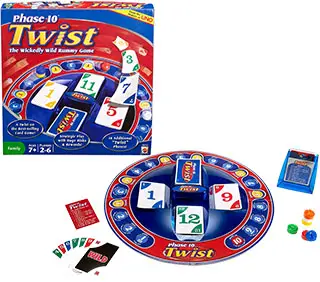
Components
- 112-Card Deck of Phase 10 Cards
- Twist Card Holder
- Phase 10 Twist Game Board with Card Tray
- 6 Pawns
- Instructions
Object of the Game
Move around the game board and be the first to finish Phase 10.
Setup
Separate the reference cards from the rest of the Phase 10 deck and place them around so all can see them.
Place the Twist Phase Cards in the Twist Phase Card Holder.
Unfold the game board and place it within easy reach of all players.
Set the Phase 10 Twist Card Tray in the center of the game board
Shuffle the deck of Phase 10 cards and deal 10 cards, face-down, to each player.
Place the rest of the deck face down in one section of the Phase 10 Card Tray to form the Draw Pile. Turn the top three cards over and place them face-up, one in each of the three other sections, to form three Discard Piles.
Everyone chooses a colored pawn and places it on the "1/Start" space on the game board. Note that the pawns stack on each other, so more than one pawn may occupy a single space at any time during play.
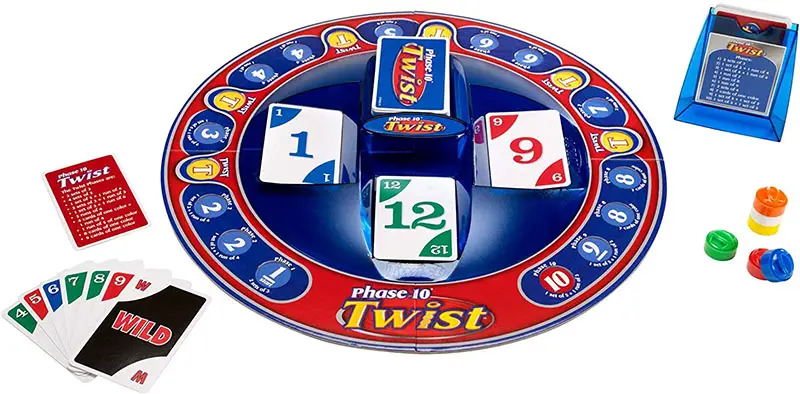
Game Play
Hold your cards so nobody else can see them. Play starts with the player to the left of the dealer and proceeds to the left. During the first hand, everybody must try to complete Phase 1.
On your turn, first draw a card either from the Draw Pile or from one of the three Discard Piles, and add it to your hand. If possible, do one of the following:
Lay down your Phase (Each player can make only one Phase during each hand), -OR-
Once you have laid down your Phase, you may "Hit" on any of the Phases that have been laid down, including your own.
At the end of your turn you must discard one card onto any of the three discard piles, or, if you choose, you may play a Skip card from your hand.
If you draw the last card from one of the Discard Piles, you must discard back into the empty section of the card tray.
The player to the left now begins their turn.
Phases
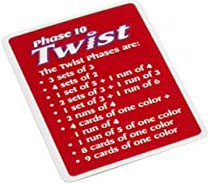
A Phase is a combination of cards made of sets, runs, cards of one color, or a combination of any of those.
This process is described in greater detail in the "Laying Down a Phase" section. These are the Ten Phases:
- 2 sets of
- 1 set of 3 + 1 run of 4
- 1 set of 4 + 1 run of 4
- 1 run of 7
- 1 run of 8
- 1 run of 9
- 2 sets of 4
- 7 cards of one color
- 1 set of 5 + 1 set of 2
- 1 set of 5 + 1 set of 3
Definitions
-
Set: A set is made of two or more cards with the same number.
-
Run: A run is made of four or more cards numbered in order.
-
One Color: The cards are all of the same color.
-
Skip Cards: Skip cards cause another player to lose a turn. When you discard at the end of your turn, instead of placing a card in one of the three Discard Piles, place the Skip card in front of the player you choose. They will lose their next turn.
When you draw a Skip card, you may discard it immediately or save it for a later turn.
A Skip card may never be used in making a Phase.
Only one Skip card may be used against each player per round (around is once around the table).
If any of the discard piles are started with a Skip card, cover it with a new card from the draw pile.
Important: Make certain that all played Skip cards are shuffled back into the deck at the start of the next hand.
-
Wild Cards: A Wild card may be used in place of any number card, or may be used as any color, in order to complete a Phase.
You may use any number of Wild cards, but you must use at least one (1) natural card when you lay down a Phase.
Once a Wild card has been played in a Phase, it cannot be replaced by the intended card and used elsewhere, but must remain as that card until the hand is over.
If the discard pile is started with a Wild card, it may be picked up in play like any other card.
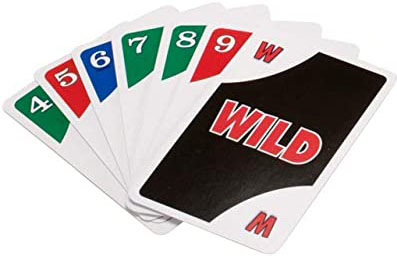
Laying Down a Phase
If, during your turn, you're able to make a Phase with the cards in your hand, lay down the Phase face-up on the table before discarding.
You may not lay down parts of a Phase unless you have the complete Phase. You may lay down more than the minimum requirements of a Phase, but only if the additional cards can be directly added to the cards already in the Phase.
Only one Phase can be made per hand. You must make the Phase designated by the space you occupy on the game board, regardless if you hold the makings of a different Phase.
A Phase is considered complete as soon as you lay it down. You do not need to win the hand in order to receive credit for the Phase. Often, several different players will complete a Phase during the same hand.
Hitting
Hitting is the way to get rid of leftover cards after laying down a Phase.
You "hit" by putting a card directly on a Phase that's already laid down.
The card must properly fit with the cards already down.
Important: Before you can make a hit, your own Phase must already be laid down. You may hit only during your turn. You may hit your own cards, another player's cards, or both.
Going out / Finishing a Hand
After laying down a Phase, players try to "Go Out" as soon as possible. To Go Out, you must get rid of all of your cards, by discarding or hitting.
As soon as any player Goes Out, the hand is finished and pawns are moved.
Pawn Movement
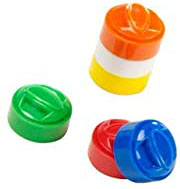
Everyone moves their own pawn after each hand:
- Move 3 spaces if you "Go Out".
- Move 2 spaces if you completed your Phase, but did not get rid of all of your cards.
- Move 1 space even if you did not complete your Phase (except when you're on the Phase 10 space).
Game Board Spaces
If you land on a numbered space, the number designates the Phase you must lay down. Example: If you land on a space marked with a "3, "you will try to complete Phase 3, If you land on a space marked with a "7, "you will try to complete Phase 7.
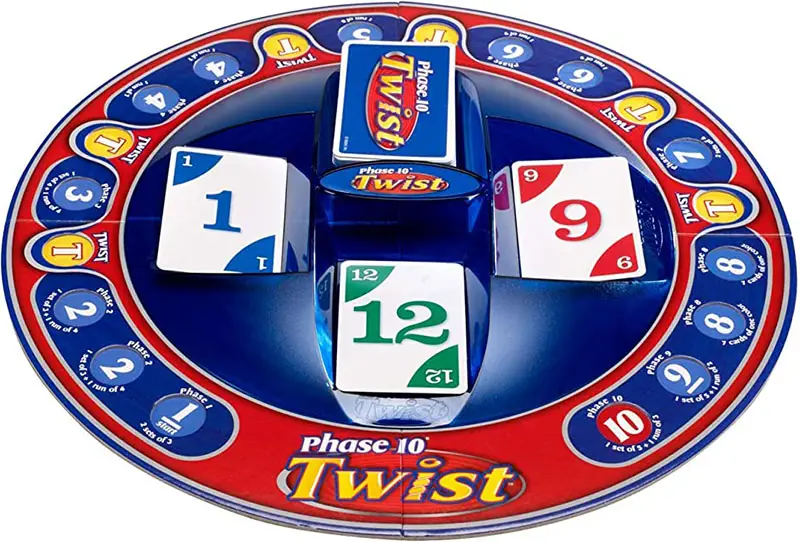
If you land on the PHASE 10 Space...
The 10th Phase space on the game board is colored RED and is different than other game board spaces: you do not move 1 space while on it... you must lay down your Phase, in order to move past the Phase 10 space. You may skip over the 10th Phase space by earning a 2 or 3-space move from one of the two preceding spaces.
If you land on a TWIST Space.
After the next hand has been dealt and you've reviewed your cards, you may:
Choose to complete one of the two Phases that are on either side of your Twist space on the board-or-
Draw a Twist Phase card from the Twist card holder
If you draw a Twist Card, you must make the Phase it designates, which will be one of the following:
- 3 sets of 3
- 4 sets of 2
- 1 set of 5 + 1 run of 4
- 2 sets of 3 + 1 run of 3
- 1 set of 3 + 1 run of 6
- 2 runs of 4
- 4 cards of one color + 1 run of 4
- 1 run of 5 of one color
- 8 cards of one color
- 9 cards of one color
There is a risk and potential reward to taking a Twist Phase card:
The Risk - if you don't complete (lay down) the designated Twist Phase before the hand is finished, you'll have to move backward 1 space.
The Reward - you get to double the usual moves: Complete your Twist phase and move 4 spaces instead of 2. Go Out on your Twist Phase and move 6 spaces instead 3.
You don't have to reveal what Twist Phase you are trying to complete until after you lay it down. There are no extra moves awarded for selecting either of the Phases that are on either side of the Twist space; you simply advance from the Twist space as noted in the Pawn Movement section.
End of the Game
If you're the first player to move past Phase 10, you win! If more than one player moves past Phase 10 at the same time, the player who Goes Out during that last round of play, is the winner.
If there's a tie (2 players lay down but don't Go Out), then, each player totals the value of each number card remaining in their hand.
The player with the lowest total is the winner. (Skips count as 15 points. Wild cards count as 25 points).
Continue Reading


